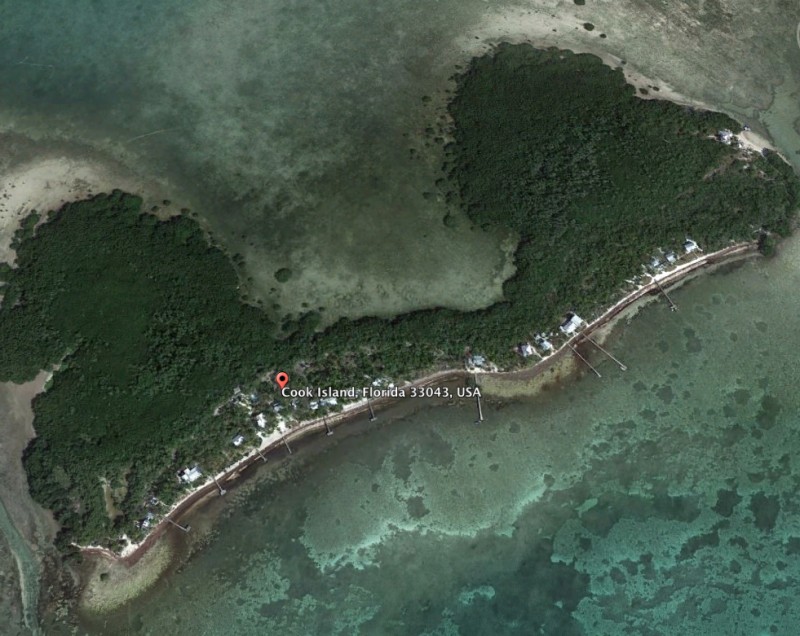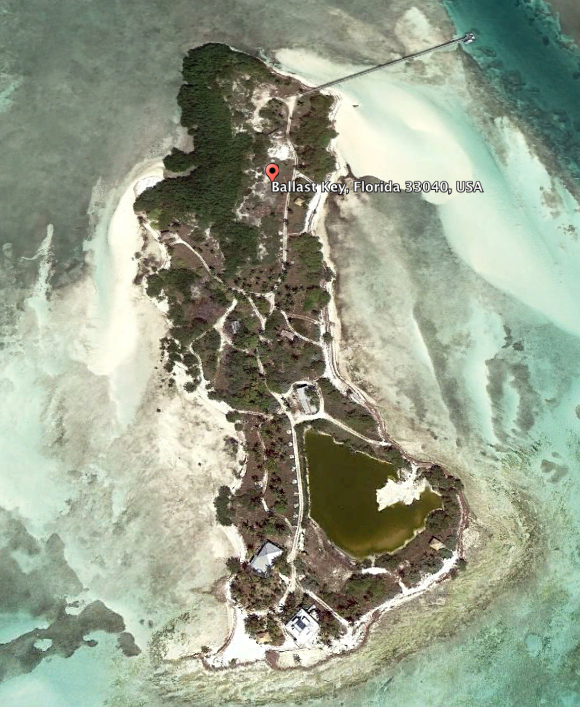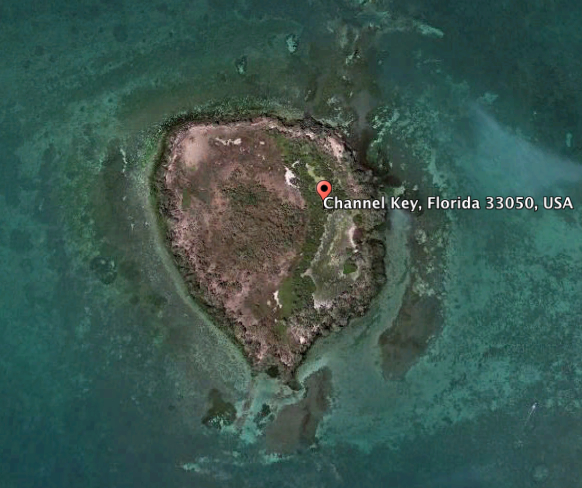SOME BURNING QUESTIONS ABOUT OFFSHORE ISLANDS
Sore throats, red eyes, Old Town storeowners worried about the smell of smoke on their garments, sailboats evacuated… One way or another a lot of people were affected last week by the fire raging on Wisteria Island. The Key West Fire Department had given up the fight on Monday and the fire continued on, burning through trees for six days. In the end the flames were extinguished only after a group of volunteers took the matter into their own hands last Saturday.
“We traded buckets all day, from the beach all the way into the center of the forest,” says Jeff Sundwall one of the volunteers. We had teenage kids, young mothers, boaters, people from Key West came with their boats. We worked from morning to sunset.”
By then, the team of about 8 people, organized by local activist Mike Mongo, covered in soot and exhausted, equipped only with buckets and 500 feet of garden hose connected to a small 12-volt pump, had managed to extinguish the flames down to the last cluster of burning trees.
“The ground was so hot, the glue in my sneakers melted and the soles fell off,” says Satya Wildwood.
“It was really sad to see the island on fire,” says Leilani Davis, 16, who is growing up on an anchored boat nearby, “I found the shell of this huge hermit crab that I had marked for a school project, “Hector the Crab” was all shriveled up dead laying next to his shell and there were butterflies shriveled up in the bark of the trees. Just sad.”
Things were worse for the group of homeless campers who may have caused the fire. They were stranded after the fire burned their dinghy and the flames passed through their campsite. They claim they spent days trying to extinguish the clusters of fire which seemed bound to surround them.
So why was the fire allowed to continue burning for so long? According to Key West Fire Marshal Danny Blanco, Wisteria is not within the department’s jurisdiction and they had not received any calls for service.
On the Facebook group page “1000 Friends in Support of Keeping Wisteria (Christmas Tree Island) Natural”, administered by Mongo, many commentators saw the deliberate failure to stop the fire as a step toward development.
“I trust them to use every trick in the book to take over the island for development,” wrote Bill Estes, “Developers will be calling for building on the island soon because after all it’s no longer a “Forested Area”.
Since 2010, Roger Bernstein’s hotel/marina project team has wrestled with environmental issues. Last Stand brought in renowned botanist Roger Hammers who surveyed the island and found 75 diverse species of native plants including several protected species. Another survey established the probability that a significant colony of Threatened White-crowned pigeons were nesting on the island. Then in the summer of 2012, FWC documented turtle nesting on the beach.
Under current County land regulations such factors could ultimately result in prohibition of development on the island. So, if you are poised to gain millions in development rights and you don’t mind smoking out your neighbors for a week or so, letting the fire continue to do its work freely might seem like a good idea.
Last Friday’s County Commission meeting in Marathon offers an interesting glimpse at the results of behind the scenes maneuvering by the Wisteria Island development team.
Wisteria Island’s would-be developers were not simply standing idle while the island burned, they were also enjoying the enactment of some very beneficial loophole legislation that could have far reaching effects on the entire county.
Ironically, while Wisteria Island’s forest was on fire a confusing Comprehensive Plan amendment was making its way to the Board of County Commissioners and it was all about offshore island development. It should have been about ALL offshore islands, but apparently Roger Bernstein’s lobbyists have got the commission so polarized and obsessed with Wisteria Island that the discussion went into tunnel vision mode immediately and Wisteria was the only thing they could see.
Only Commissioner Sylvia Murphy made an effort to break the hypnotic link. “Why are we so worried about Wisteria Island?” she asked, “Why are we so worried about that island in particular?” Fellow Commissioner Danny Kolhage responded, “Because you’re probably going to get a visit soon, if you haven’t already.”
What is going on? People who, like Roger Bernstein, want to build resorts on offshore islands need a Comprehensive Plan amendment. For many years, up until last Friday, it was clear that all offshore islands were automatically assigned a “Tier I” status, which meant, along with other obstacles, that no development rights could be transferred to them and they were for the most part non developable.
Within the past four years Bernstein’s lawyers have made multiple attempts to change that and obviously those little “visits” Kolhage was referring to last Friday have finally begun to pay off. Under newly approved Policy 206.1.2 only offshore islands that have no “prior development” AND no “substantial upland habitat” will necessarily be assigned to Tier I.
As developers tend to do, Bernstein has tried [and apparently managed] to convince government officials that the little favor he needs will involve only his unique situation and will not create any problematic precedent in Monroe County.
When Kolhage asked staff how many more Wisteria-like islands were out there, Growth Management Director Christine Hurley explained, “its very minimal. We have more than one – yes.” But staff could only point to one “up near Duck Key” which was not even mentioned by name and readily admitted that the County has no idea how much “substantial” or “unsubstantial” upland habitat is actually out there.
In fact, readily available records show that there are at least 57 privately owned offshore islands in Monroe County comprising almost 3000 square acres. Until Friday, other than Wisteria Island and Pumpkin Key, all offshore islands had already been designated as Tier I by definition. But thanks to this “Wisteria Island Amendment” things could now change drastically.
A preliminary Google Earth survey of those privately owned islands shows that many have prior development which in itself under the new law implies that owners of those islands could seek a change in Tier designation under the new policy on that basis alone.
Several of these privately owned islands also show expanses of what appears to be scarified upland and with a little help from providential forest fires or “mysterious blights” any “significant upland habitat” found on these islands could also disappear and subsequently trigger an application for a change in Tier designation and plans for a new resort.
However, despite the possible consequences of the new language, the Commission focused entirely on whether or not the new policy would have a negative affect on Bernstein’s development plans [in the event he wins his ownership dispute against the United States. See Blue Paper coverage of that subject here.]
“Do they [Wisteria] have ‘significant upland habitat’,” asked Sylvia Murphy.
Commissioner Carruthers: “Ha, ha, ha… not any more.”
Commissioner Rice: “Whatever habitat they had there last week they have a lot less now. I flew over yesterday and it’s back on fire.”
Biological consultant Robert Ehrig, an expert in Native trees and Cactus of the Keys with over thirty-five years of experience, disagrees with Commissioner Rice’s view of the impact of the fire. According to Ehrig, who visited the island last Thursday, there were no more than three or four acres of the 21-acre island that had been affected. The fire mainly fed on dead Australian pine and pine needles. Ehrig says most of the Gumbo limbo and Thatch palms that were affected by the fire appeared likely to recover. On the rest of the island he found: “probably the most significant colony of Bay Cedar and Black Torch I’ve ever seen in the Keys.” It appears that despite the fire, the native vegetation and the possibility of nesting birds will continue to be a thorn in the would-be developers’ side.
In the meantime, Roger Bernstein appears to be welcoming homeless campers to Wisteria. He was quoted last week saying: “people are legally allowed to be living on the island and we have had issues with cooking fires getting out of control in the past” and, he added, “we have had fires caused by lightening in the past.”
Noting that Sunset Key had also taken fire prior to development, one Facebook group page member wrote: “The exact term is ‘developers’ lightening’.”
~~~~~~~~~~~~~~~~~~~
Full disclosure: The authors, Arnaud and Naja Girard, were among the volunteers who helped to extinguish the fire on Wisteria Island and it was they who reminded the U.S. government of their decades old claim to the island which led to the present dispute regarding ownership. Naja Girard is the current President of the local environmental advocacy group Last Stand.



It has been my understanding for some time, Roger Bernstein admitted it at a county commission meeting maybe three years ago, that his adviser for developing Wisteria Island is Jim Hendrick, former Monroe County Attorney, former practicing lawyer, who eventually was prosecuted in Federal Court for witness tampering and conspiracy secondary to allegations that, while County Attorney, he had facilitated a bribe of County Commissioner Jack London. By the time the US Attorney got around to prosecuting Hendrick in Federal Court, the statute of limitations had run on the bribery allegation, so the other two charges were brought by the US Attorney against Hendrick. He was found guilty by the jury, and was put on probation, and was disbarred, but he continued to advise real estate developers at a “consultant”. He started a new company, “Critical Concern, Inc.”, borrowing from the Florida Keys previously being designated an area of critical concern (environmentally) by the Florida Legislature. Hendrick is a good buddy of and adviser to the developer Pritam Singh. Hendrick advises other developers. I heard Jim tell someone once, who had asked if he, Jim, would ever try to get his law license reinstated?, probably not, he was doing everything he did when he practiced law but go to court.
Jim also is the Peary Court developer’s adviser.
The only critical concern I ever saw in a developer was making as much money as possible.
As for who started the fire on Wisteria: Were the flare-shooters acting on their own; were they put up to it? We may never know. But it is said that shortly after Hurricane Wilma, aircraft were seen dumping chaffe on Wisteria Island, and then the thick canopy of Australian pines begin a serious die-off. The Bernsteins got Florida Fish & Wildlife (FWC) Lieutenant David Diprie (now Captain Diprie) to star in a promo film knocking the natural Wisteria Island and promoting it being remade into something like Sunset Key nearby. Later, Diprie altered a trespass incident report in a case against a man for going onto Wisteria Island. Diprie told me on a speaker phone from then State Attorney Dennis Ward’s office that he had made a scrivener’s error. I replied that I did not believe him.
At a county commission meeting maybe 2 years ago, Commissioner George Neugent boasted about being a good friend with FWC Lieutenant David Diprie, and about knowing all there was to know about Wisteria Island, so during citizen comments, I told George a few things he did not know about Wisteria Island and his good friend David Diprie, including maybe the Bernsteins did not even own the island, but maybe the US Government owned it.
Naja had dug up evidence that maybe the US actually did own Wisteria Island, and she passed that evidence along to the US Department of the Interior, and they waffled, then decided maybe the US Government did own the island, and they made that claim, and that is what forced the Bernsteins to file suit in Federal Court to try to get the title quieted into them.
I had told Naja the angels were telling me in dreams for her to keep digging, there was something there she had not yet found, and she had kept digging, and that had led to what she presented to the Feds, and to the Bernsteins filing suit in Federal Court.
Whether because of ecological illiteracy, political expediency, or back room deals, the idea that the fire destroyed Wisteria Island is absurd and disingenuous. Changed? Yes. Destroyed? Absolutely not. A barren island created from dredged spoil, Wisteria Island, decades later the island harbored 75 native plant species and a host of butterfly and bird species.
By the end of the rainy season, the island will be covered with herbaceous plants, including nectar producing species so important to butterflies.
Think about it — vegetated areas worldwide are temporarily laid barren by fires, hurricanes, droughts, and floods, yet they recover over time. The only thing that can destroy Wisteria Island is development.
The fire ruse is just another step in the plan to develop the island. The Bernsteins and the big money developer waiting in the wings will not stop until the island is cleared, approvals granted and more luxury hotel units are built. Scorched earth at all cost. Literally and figuratively.